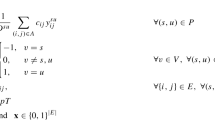Abstract
In this article, we introduce the two-level diameter constrained spanning tree problem (2-DMSTP), which generalizes the classical DMSTP by considering two sets of nodes with different latency requirements. We first observe that any feasible solution to the 2-DMSTP can be viewed as a DMST that contains a diameter constrained Steiner tree. This observation allows us to prove graph theoretical properties related to the centers of each tree which are then exploited to develop mixed integer programming formulations, valid inequalities, and symmetry breaking constraints. In particular, we propose a novel modeling approach based on a three-dimensional layered graph. In an extensive computational study we show that a branch-and-cut algorithm based on the latter model is highly effective in practice.






Similar content being viewed by others
References
Achuthan, N.R., Caccetta, L., Caccetta, P., Geelen, J.F.: Computational methods for the diameter restricted minimum weight spanning tree problem. Australas. J. Comb. 10, 51–71 (1994)
Botton, Q., Fortz, B., Gouveia, L., Poss, M.: Benders decomposition for the hop-constrained survivable network design problem. INFORMS J. Comput. 25(1), 13–26 (2013)
Cherkassky, B.V., Goldberg, A.V.: On implementing push-relabel method for the maximum flow problem. Algorithmica 19, 390–410 (1994)
Deo, N., Abdalla, A.: Computing a diameter-constrained minimum spanning tree in parallel. In: Bongiovanni, G.C., et al. (eds.) CIAC, volume 1767 of LNCS, pp. 17–31. Springer, Berlin (2000)
Gouveia, L., Magnanti, T.L.: Network flow models for designing diameter-constrained minimum-spanning and Steiner trees. Networks 41(3), 159–173 (2003)
Gouveia, L., Magnanti, T.L., Requejo, C.: A 2-path approach for odd-diameter-constrained minimum spanning and Steiner trees. Networks 44(4), 254–265 (2004)
Gouveia, L., Magnanti, T.L., Requejo, C.: An intersecting tree model for odd-diameter-constrained minimum spanning and Steiner trees. Ann. OR 146(1), 19–39 (2006)
Gouveia, L., Magnanti, T.L., Requejo, C.: Tight models for special cases of the diameter-constrained minimum spanning tree problem. In: Proceedings of the 3rd International Network Optimization Conference, Spa (2007)
Gouveia, L., Simonetti, L., Uchoa, E.: Modeling hop-constrained and diameter-constrained minimum spanning tree problems as Steiner tree problems over layered graphs. Math. Program. 128, 123–148 (2011)
Grötschel, M., Monma, C.L., Stoer, M.: Computational results with a cutting plane algorithm for designing communication networks with low-connectivity constraints. Oper. Res. 40(2), 309–330 (1992)
Gruber, M.: Exact and Heuristic Approaches for Solving the Bounded Diameter Minimum Spanning Tree Problem. PhD thesis, Vienna University of Technology, Vienna, Austria (2009)
Gruber, M., Raidl, G.R.: A new 0–1 ILP approach for the bounded diameter minimum spanning tree problem. In: Proceedings of the 2nd International Network Optimization Conference, pp. 178–185, Lisbon (2005)
Gruber, M., Raidl, G.R., et al.: (Meta-)heuristic separation of jump cuts in a branch &cut approach for the bounded diameter minimum spanning tree problem. In: Maniezzo, V. (ed.) Matheuristics, Volume 10 of Annals of Information Systems, pp. 209–230. Springer, Berlin (2010)
Huygens, D., Labbé, M., Mahjoub, A.R., Pesneau, P.: The two-edge connected hop-constrained network design problem: valid inequalities and branch-and-cut. Networks 49, 116–133 (2007)
Kerivin, H., Mahjoub, A.R.: Design of survivable networks: a survey. Networks 46, 1–21 (2005)
Ljubić, I., Weiskircher, R., Pferschy, U., Klau, G., Mutzel, P., Fischetti, M.: An algorithmic framework for the exact solution of the prize-collecting Steiner tree problem. Math. Program. 105, 427–449 (2006)
Mahjoub, A.R., Simonetti, L., Uchoa, E.: Hop-level flow formulation for the survivable network design with hop constraints problem. Networks 61, 171–179 (2013)
Manyem, P., Stallmann, M.F.M.: Some Approximation Results in Multicasting. Technical Report TR-96-03, North Carolina State University at Raleigh, NC, USA (1996)
Noronha, T.F., Ribeiro, C.C., Santos, A.C.: Solving diameter-constrained minimum spanning tree problems by constraint programming. Int. Trans. Oper. Res. 17(5), 653–665 (2010)
Salama, H.F.: Multicast Routing for Real-Time Communication on High-Speed Networks. PhD thesis, Department of Electrical and Computer Engineering, North Carolina State University (1996)
Salama, H.F., Reeves, D.S., Viniotis, Y.: Delay-Constrained Shared Multicast Trees. Technical Report, Department of Electrical and Comp. Engg., North Carolina State Univ., USA (1996)
Santos, A.C., Lucena, A., Ribeiro, C.C.: Solving diameter constrained minimum spanning tree problems in dense graphs. In: Ribeiro, C.C., Martins, S.L. (eds.) WEA, volume 3059 of LNCS, pp. 458–467. Springer, Berlin (2004)
Vik, K.H., Halvorsen, P., Griwodz, C.: Multicast tree diameter for dynamic distributed interactive applications. In: INFOCOM, pp. 1597–1605. IEEE (2008)
Author information
Authors and Affiliations
Corresponding author
Additional information
L. Gouveia is supported by National Funding from FCT—Fundação para a Ciência e Tecnologia, under the project: PEst-OE/MAT/UI0152. M. Leitner is supported by the Austrian Science Fund (FWF) under grant I892-N23. I. Ljubić is supported by the APART Fellowship of the Austrian Academy of Sciences. These supports are greatly acknowledged.
Appendix
Appendix
Rights and permissions
About this article
Cite this article
Gouveia, L., Leitner, M. & Ljubić, I. The two-level diameter constrained spanning tree problem. Math. Program. 150, 49–78 (2015). https://doi.org/10.1007/s10107-013-0743-z
Received:
Accepted:
Published:
Issue Date:
DOI: https://doi.org/10.1007/s10107-013-0743-z




